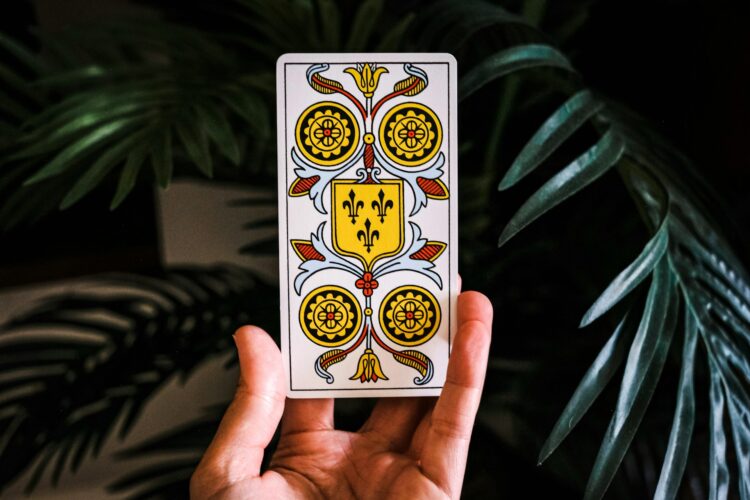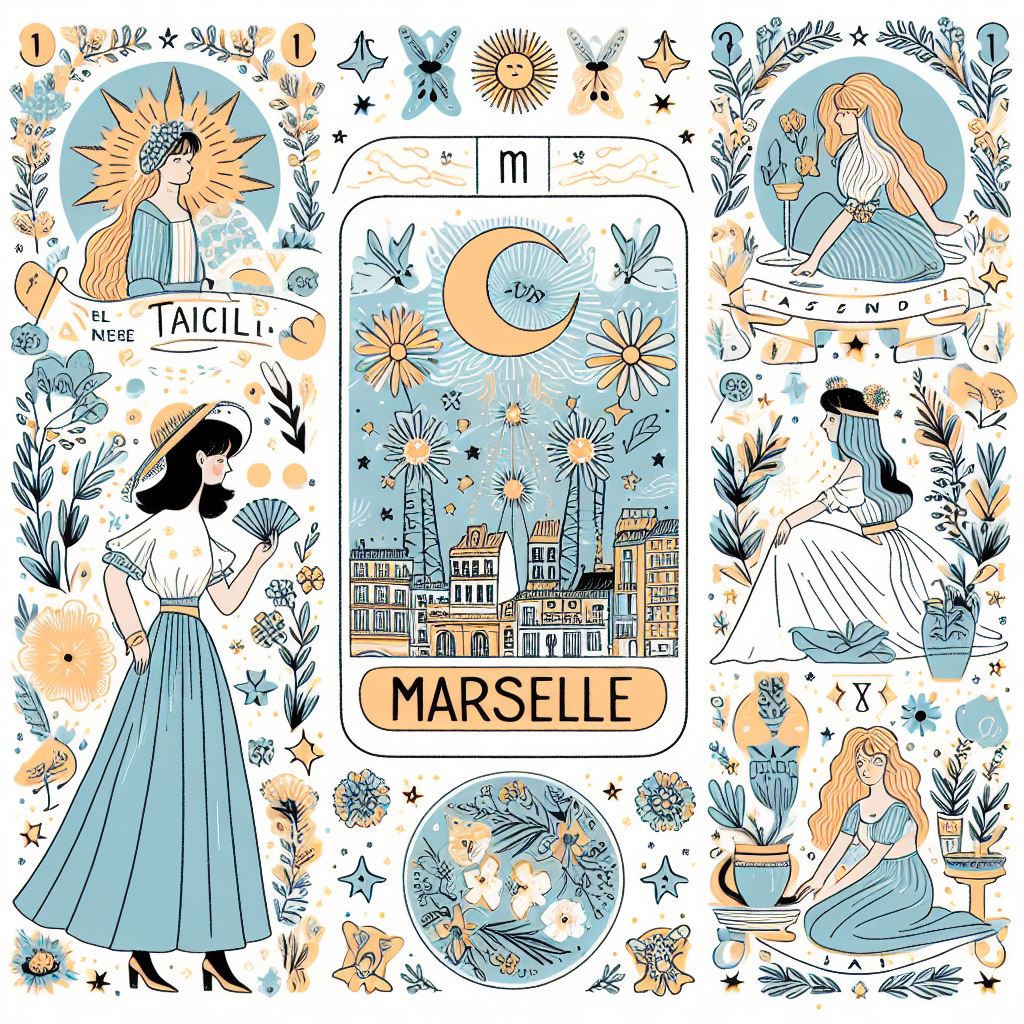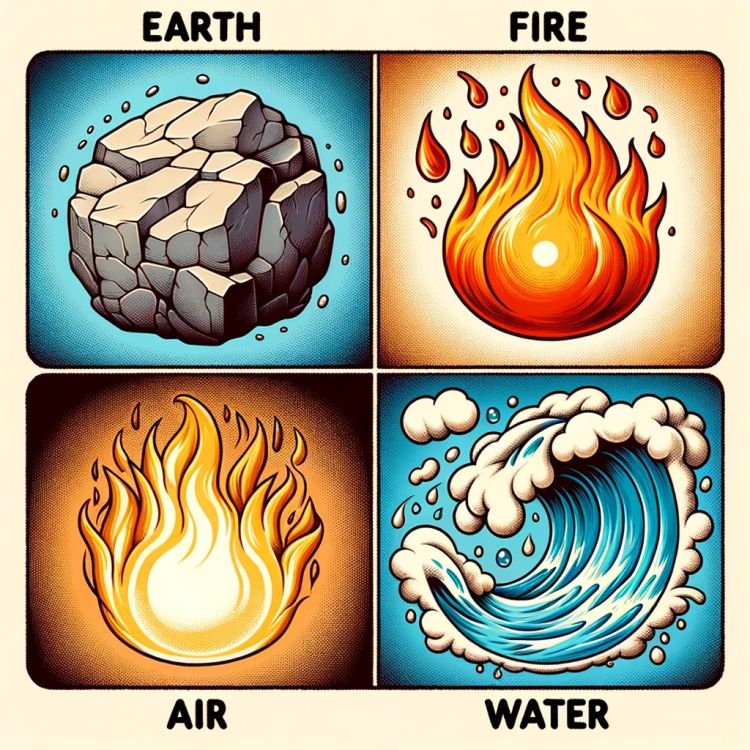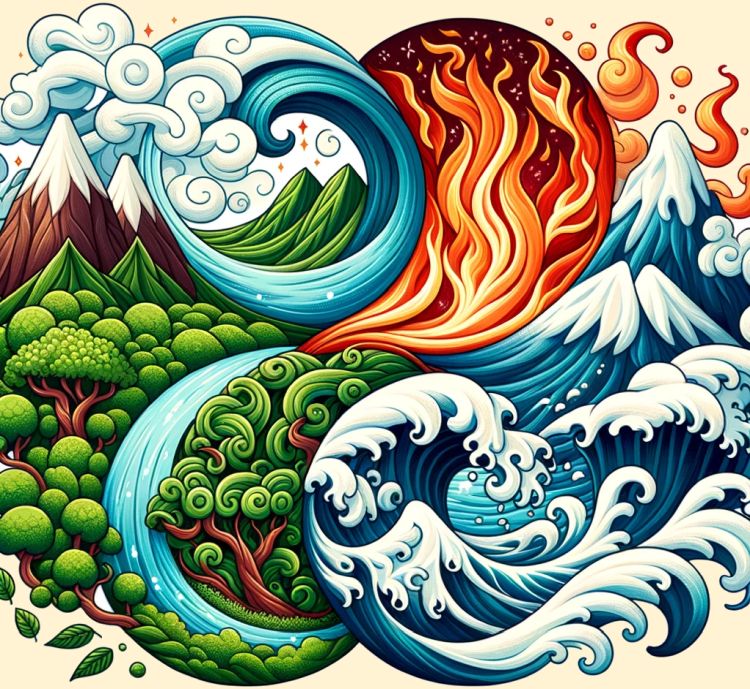The Time-Honored Wisdom of the Tarot of Marseille

The Tarot of Marseille, a rich and mysterious cultural heritage, is much more than a mere deck of cards. It is a mirror of the soul, a spiritual guide that has traversed the centuries, capturing the essence of ancient philosophies, Renaissance arts, and occult sciences such as astrology and alchemy. Each card is an open door to the unconscious, a reflection of the archetypes that inhabit our psyche.
The four Latin suits of the tarot – coins, wands, swords, cups – are the pillars of this symbolic system. The coins, representing earth, evoke materiality, prosperity, and all that is tangible. The wands, linked to the element of fire, symbolize creative energy, action, and will. The swords, associated with air, represent intellect, justice, and conflicts. Finally, the cups, connected to water, embody emotions, intuition, and relationships.
These symbols are reminiscent of the classic French suits – clubs, spades, diamonds, hearts – which also have their own symbolic language. The club evokes luck and nature, the spade is often associated with nobility and courage, the diamond refers to wealth and commerce, and the heart, of course, is the universal symbol of love and passion.
Exploring these symbols invites us on an inner journey, to discover our own psychological riches. They help us understand our deep motivations, clarify our thoughts, and harmonize our emotions. In short, the Tarot of Marseille and the classic French cards are valuable tools for personal development and the quest for inner serenity. They offer us a path to better self-knowledge and a more balanced and fulfilled life.
The definitions that follow are drawn from an interesting article on an original and unique meaning of the 78 tarot cards.
Part I: Coins and Clubs, Matter and Prosperity

In the timeless journey through the arcana of the Tarot of Marseille, the coins hold a place of honor, symbolizing materiality and abundance. These golden discs are not mere representations of financial wealth; they reflect the security, stability, and prosperity that can be achieved through work and effort. In astrology, the coins are associated with the element of earth, recalling fertility, growth, and the concrete manifestation of ambitions. In alchemy, they represent the transformation of the base into the precious, a process that can be seen as a metaphor for personal evolution and self-development.
The club, in the classic French deck of cards, shares this connection with the earth and materiality. Representing the working classes, the club is a symbol of luck, prosperity, and stable growth. It evokes unity and simplicity, values that nourish society just as peasants nourish the earth. In the context of personal development, the club can be seen as a reminder of the importance of humility, hard work, and the recognition of life’s small blessings.
The comparison between coins and clubs reveals a fundamental similarity in their symbolism related to prosperity and materiality, but also a divergence in their approach to wealth. The coins, with their golden luster, emphasize the accumulation and preservation of wealth, while the club, more modest, highlights luck and organic growth. In our quest for well-being, these symbols invite us to balance our desire for material security with our need for personal and spiritual growth. They remind us that true prosperity lies in the richness of our inner world and in our ability to appreciate and cultivate the resources we already have at our disposal.
Part II: Wands and Spades, Action and Intellect

In the rich universe of the Tarot of Marseille, the Wands embody creative energy and ambition. They are the inner fire that drives action, initiative, and the realization of projects. This suit resonates with ancient philosophies, where action and will were seen as vehicles for human excellence. The paintings of the Renaissance, with their celebration of the individual and their achievements, also reflect this valorization of ambition and willpower.
In modern psychology, the Wands can be interpreted as a symbol of our potential for motivation and personal development. They remind us that action is often the first step towards change and self-improvement. When we draw these cards, they can invite us to reflect on our level of commitment to our goals and how we mobilize our energy to achieve them.
On the other hand, the Spade, in the classic French deck of cards, is associated with intellect and analytical thinking. It represents intellectual challenges, obstacles to overcome, and the ability to make sharp decisions in complex situations. The Spade confronts us with our fears and internal struggles, urging us to use our minds to navigate through life’s difficulties.
The distinction between Wands and Spades is subtle yet significant. While Wands encourage us to act and manifest our desires in the external world, Spades urge us to sharpen our minds and use our intelligence to solve problems. Together, these two suits offer a balance between dynamic action and strategic reflection, essential for harmonious personal growth.
In our quest for personal development, Wands and Spades serve as guides. Wands motivate us to take initiatives and pursue our passions, while Spades remind us of the importance of reflection and analysis. By integrating these principles into our daily lives, we can find a path to greater self-realization and improved mental health.
Part III: Swords and Diamonds, Conflict and Social Interaction

In the Tarot of Marseille, Swords are a powerful symbol of conflict, but also of justice and truth. They confront us with our internal and external struggles, inviting us to cut through to clarity and resolution. The writings of Francesco Petrarca, with their exploration of human emotions and moral condition, resonate with this quest for truth and balance that the Swords represent.
Swords push us to communicate honestly and use our intellect to solve problems. They remind us that, despite challenges, it is possible to find peace and harmony through justice and introspection. In personal development, Swords encourage us to face our fears and speak our truth, thus fostering inner growth and a better understanding of oneself.
Diamonds, in the classic French deck of cards, symbolize social interactions, commerce, and ingenuity. They represent wealth not only in material terms but also intellectual and social. Diamonds invite us to explore our creativity and interact with the world around us to thrive.
Compared to Swords, Diamonds emphasize the importance of exchanges and relationships in our personal development. They teach us that our well-being is often linked to our ability to communicate and establish meaningful connections with others. Diamonds encourage us to use our ingenuity to navigate the world of business and relationships, highlighting the importance of adaptability and innovation.
In summary, Swords and Diamonds offer a balance between resolving internal conflicts through truth and justice, and flourishing in the external world through social interactions and commerce. They guide us towards a deeper understanding of ourselves and our place in society, helping us to develop a richer and more balanced life.
Part IV: Cups and Hearts, Emotion and Relationships

In the timeless journey of the Tarot of Marseille, Cups emerge as the receptacle of emotions, relationships, and love. They draw their essence from the element of water, fluid and adaptable, reflecting the depth of our feelings and the complexity of our emotional bonds. The Italian paintings of the Renaissance, with their light and color, capture this same emotional intensity, while astrology teaches us about the alignment of stars influencing our sentimental lives.
Cups, in their harmonious dance, invite us to delve into our emotional intelligence, to recognize and express our most sincere feelings. They are the mirror of our interpersonal relationships, guiding us towards a deeper understanding of others and ourselves. By drawing these cards, we are called to cultivate empathy and compassion, essential qualities for authentic and fulfilling relationships.
Similarly, the Heart in the classic French cards symbolizes love in all its forms – passionate, fraternal, altruistic. It is the sign of affection, joy, and shared happiness. Historically associated with the clergy, the Heart represents kindness and benevolence, values that transcend time and cultures.
Cups and Hearts, although different in their symbolism, converge in their common quest for happiness and personal fulfillment. They teach us that opening the heart is the key to true joy and inner satisfaction. By integrating these symbols into our practice of psychological tarot and personal development, we can navigate the path of life with more grace and wisdom, enriching our experiences and relationships with the richness of love and emotion.
Conclusion
By weaving together the threads of the symbols of the four suits of the Tarot of Marseille and the classic French cards, we have explored a rich tapestry of meanings that extend well beyond mere divination. Coins and clubs, wands and spades, swords and diamonds, as well as cups and hearts, all resonate with universal themes of prosperity, ambition, conflict, and love.
These symbols, rooted in the wisdom of ancient philosophers, the writings of Francesco Petrarca, and the masterpieces of the Renaissance, are not mere passive icons. They are keys that unlock the doors of our psyche, offering perspectives on our personal development and emotional well-being. They invite us to deep introspection, encouraging us to reflect on our own journey, to recognize our strengths and confront our shadows.
Understanding these symbols can immeasurably enrich our lives. They guide us towards better self-knowledge, help us navigate the complexities of our relationships, and find a balance between our inner world and external realities. By embracing the symbolism of the tarot, we can unlock deeper levels of consciousness and self-appreciation.
Dear readers, I invite you to continue your exploration of the symbols of the four suits by continuing your reading with this article from tarotquest.fr. Whether through personal reading or by sharing your experiences with others, each card drawn is an additional step in your unique journey. May you find in the tarot a precious ally on the path to personal fulfillment and inner serenity.
